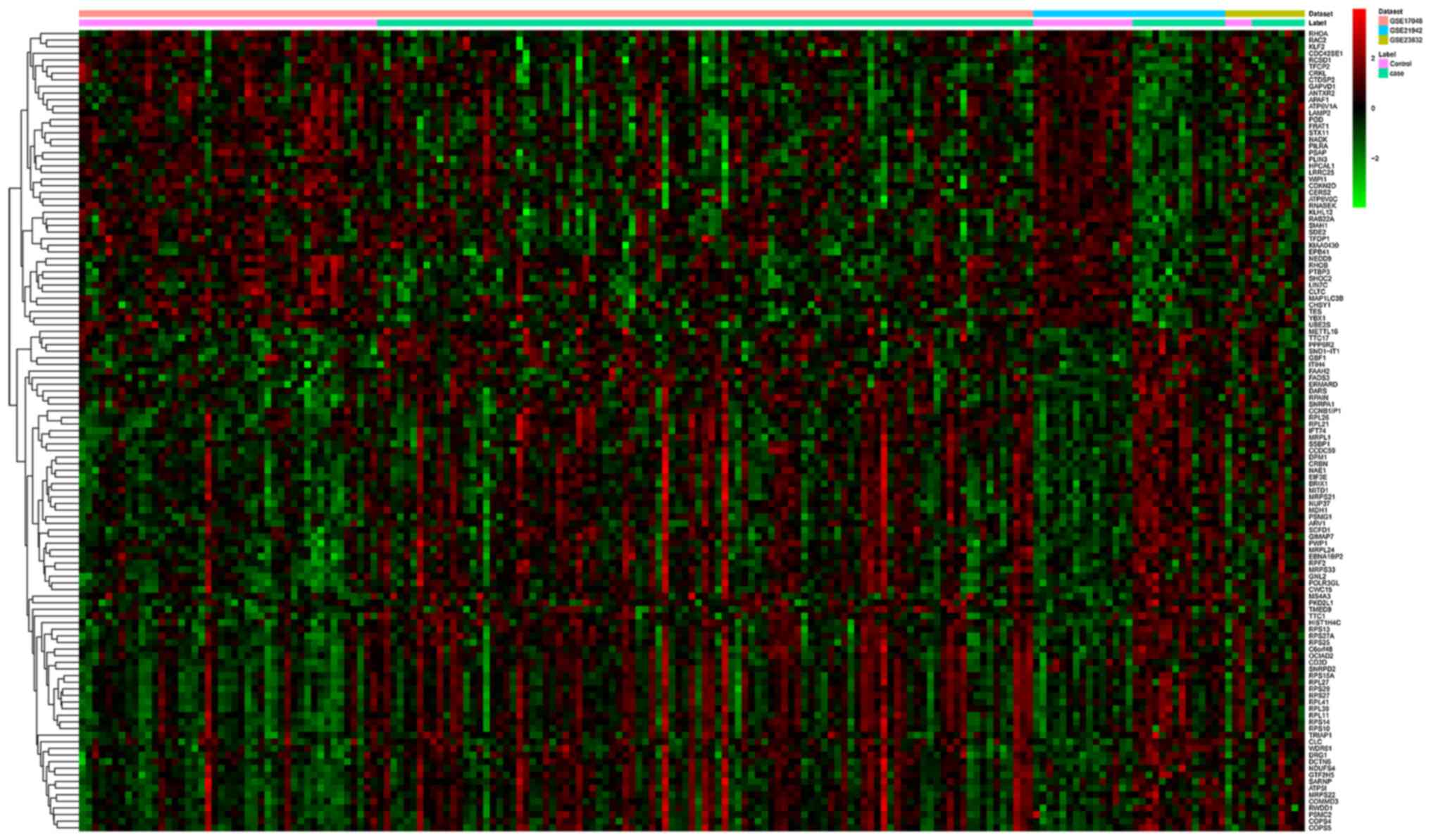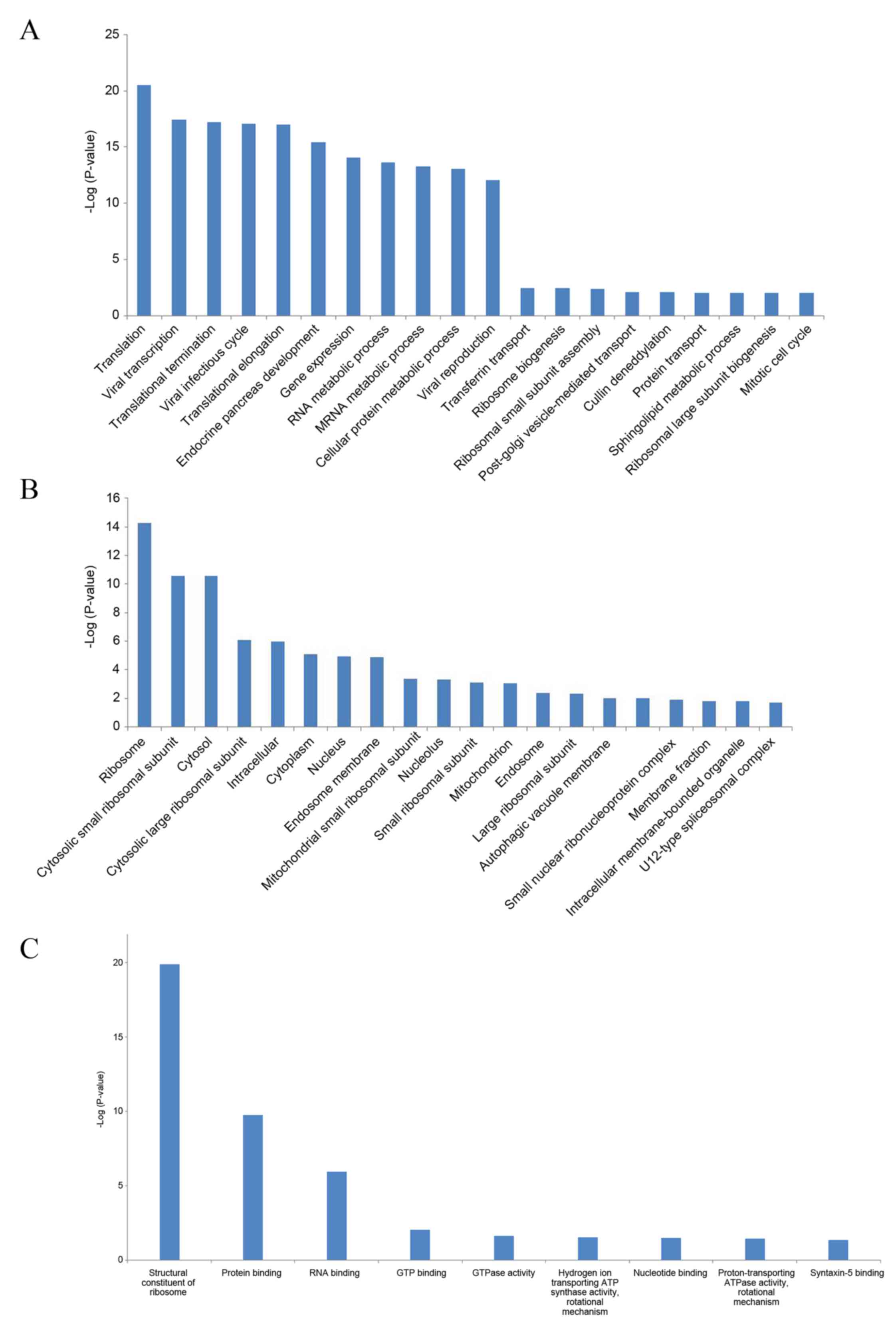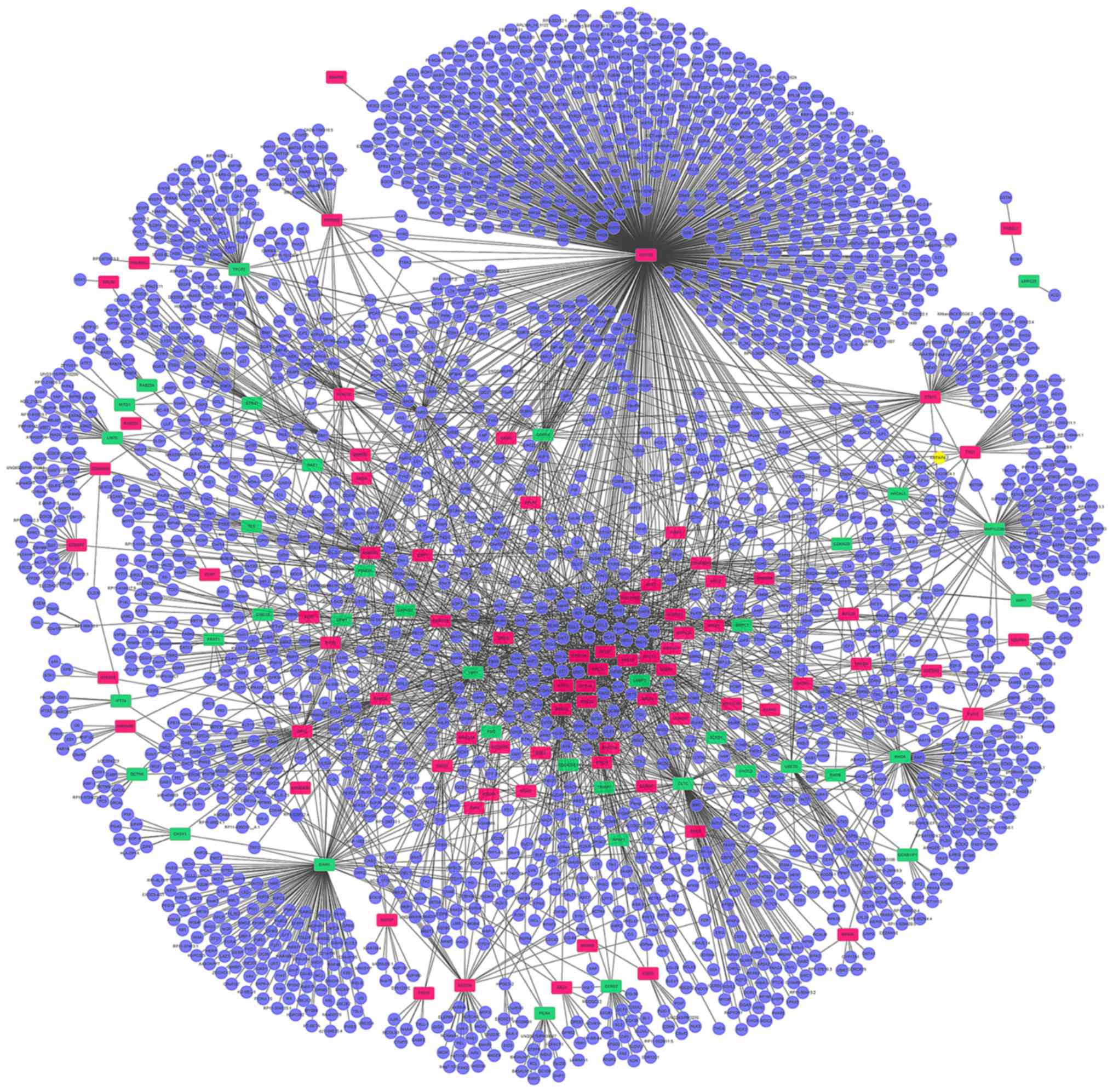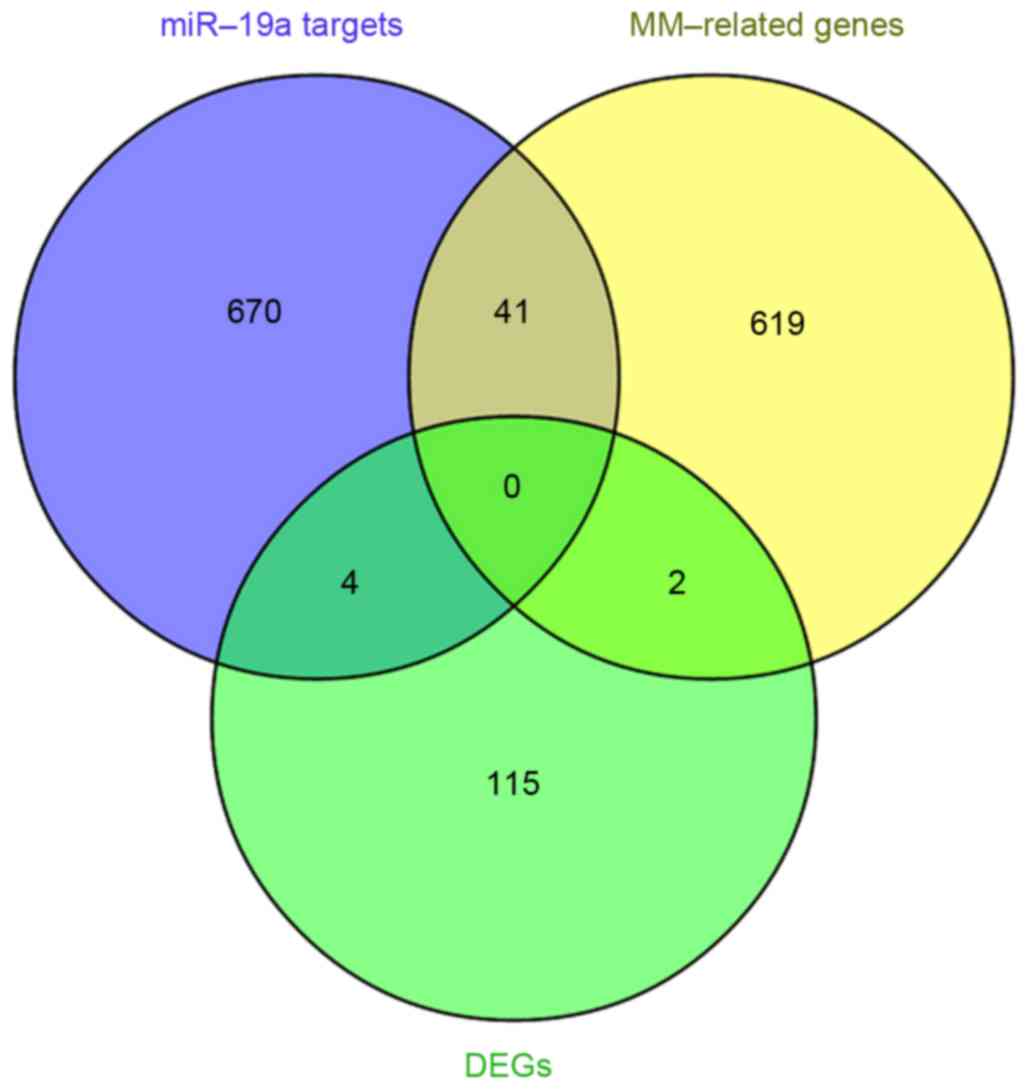|
1
|
Bommert K, Bargou RC and Stühmer T:
Signalling and survival pathways in multiple myeloma. Eur J Cancer.
42:1574–1580. 2006. View Article : Google Scholar : PubMed/NCBI
|
|
2
|
Benetatos L and Vartholomatos G:
Deregulated microRNAs in multiple myeloma. Cancer. 118:878–887.
2012. View Article : Google Scholar : PubMed/NCBI
|
|
3
|
Raab MS, Podar K, Breitkreutz I,
Richardson PG and Anderson KC: Multiple myeloma. Lancet.
374:324–339. 2009. View Article : Google Scholar : PubMed/NCBI
|
|
4
|
Dolloff NG and Talamo G: Targeted therapy
of multiple myeloma. Adv Exp Med Biol. 779:197–221. 2013.
View Article : Google Scholar : PubMed/NCBI
|
|
5
|
Chi J, Ballabio E, Chen XH, Kušec R,
Taylor S, Hay D, Tramonti D, Saunders NJ, Littlewood T, Pezzella F,
et al: MicroRNA expression in multiple myeloma is associated with
genetic subtype, isotype and survival. Biol Direct. 6:232011.
View Article : Google Scholar : PubMed/NCBI
|
|
6
|
Carthew RW: Gene regulation by microRNAs.
Curr Opin Genet Dev. 16:203–208. 2006. View Article : Google Scholar : PubMed/NCBI
|
|
7
|
Rushworth SA, Murray MY, Barrera LN,
Heasman SA, Zaitseva L and Macewan DJ: Understanding the role of
miRNA in regulating NF-kB in blood cancer. Am J Cancer Res.
2:65–74. 2012.PubMed/NCBI
|
|
8
|
Zhou Y, Chen L, Barlogie B, Stephens O, Wu
X, Williams DR, Cartron MA, van Rhee F, Nair B, Waheed S, et al:
High-risk myeloma is associated with global elevation of miRNAs and
overexpression of EIF2C2/AGO2. Proc Natl Acad Sci USA. 107:pp.
7904–7909. 2010; View Article : Google Scholar : PubMed/NCBI
|
|
9
|
Lionetti M, Biasiolo M, Agnelli L,
Todoerti K, Mosca L, Fabris S, Sales G, Deliliers GL, Bicciato S,
Lombardi L, et al: Identification of microRNA expression patterns
and definition of a microRNA/mRNA regulatory network in distinct
molecular groups of multiple myeloma. Blood. 114:e20–e26. 2009.
View Article : Google Scholar : PubMed/NCBI
|
|
10
|
Wu P, Agnelli L, Walker BA, Todoerti K,
Lionetti M, Johnson DC, Kaiser M, Mirabella F, Wardell C, Gregory
WM, et al: Improved risk stratification in myeloma using a
microRNA-based classifier. Br J Haematol. 162:348–359. 2013.
View Article : Google Scholar : PubMed/NCBI
|
|
11
|
Mendell JT: miRiad roles for the miR-17-92
cluster in development and disease. Cell. 133:217–222. 2008.
View Article : Google Scholar : PubMed/NCBI
|
|
12
|
Fuziwara CS and Kimura ET: Insights into
regulation of the miR-17-92 cluster of miRNAs in cancer. Front Med
(Lausanne). 2:642015.PubMed/NCBI
|
|
13
|
Todoerti K, Barbui V, Pedrini O, Lionetti
M, Fossati G, Mascagni P, Rambaldi A, Neri A, Introna M, Lombardi L
and Golay J: Pleiotropic anti-myeloma activity of ITF2357:
Inhibition of interleukin-6 receptor signaling and repression of
miR-19a and miR-19b. Haematologica. 95:260–269. 2010. View Article : Google Scholar : PubMed/NCBI
|
|
14
|
Pichiorri F, Suh SS, Ladetto M, Kuehl M,
Palumbo T, Drandi D, Taccioli C, Zanesi N, Alder H, Hagan JP, et
al: MicroRNAs regulate critical genes associated with multiple
myeloma pathogenesis. Proc Natl Acad Sci USA. 105:pp. 12885–12890.
2008; View Article : Google Scholar : PubMed/NCBI
|
|
15
|
Corthals SL, Sun SM, Kuiper R, de Knegt Y,
Broyl A, Van der Holt B, Beverloo HB, Peeters JK, el Jarari L,
Lokhorst HM, et al: MicroRNA signatures characterize multiple
myeloma patients. Leukemia. 25:1784–1789. 2011. View Article : Google Scholar : PubMed/NCBI
|
|
16
|
Chen L, Li C, Zhang R, Gao X, Qu X, Zhao
M, Qiao C, Xu J and Li J: miR-17-92 cluster microRNAs confers
tumorigenicity in multiple myeloma. Cancer Lett. 309:62–70. 2011.
View Article : Google Scholar : PubMed/NCBI
|
|
17
|
Gutierrez NC, Sarasquete ME,
Misiewicz-Krzeminska I, Delgado M, De Las Rivas J, Ticona FV,
Fermiñán E, Martín-Jiménez P, Chillón C, Risueño A, et al:
Deregulation of microRNA expression in the different genetic
subtypes of multiple myeloma and correlation with gene expression
profiling. Leukemia. 24:629–637. 2010. View Article : Google Scholar : PubMed/NCBI
|
|
18
|
Claudio JO, Masih-Khan E, Tang H,
Goncalves J, Voralia M, Li ZH, Nadeem V, Cukerman E,
Francisco-Pabalan O, Liew CC, et al: A molecular compendium of
genes expressed in multiple myeloma. Blood. 100:2175–2186. 2002.
View Article : Google Scholar : PubMed/NCBI
|
|
19
|
Dweep H, Sticht C, Pandey P and Gretz N:
miRWalk-database: Prediction of possible miRNA binding sites by
‘walking’ the genes of three genomes. J Biomed Inform. 44:839–847.
2011. View Article : Google Scholar : PubMed/NCBI
|
|
20
|
Zhang F, Shi Y, Wang L and Sriram S: Role
of HDAC3 on p53 expression and apoptosis in T cells of patients
with multiple sclerosis. PLoS One. 6:e167952011. View Article : Google Scholar : PubMed/NCBI
|
|
21
|
Kemppinen AK, Kaprio J, Palotie A and
Saarela J: Systematic review of genome-wide expression studies in
multiple sclerosis. BMJ Open. 1:e0000532011. View Article : Google Scholar : PubMed/NCBI
|
|
22
|
Gandhi KS, McKay FC, Cox M, Riveros C,
Armstrong N, Heard RN, Vucic S, Williams DW, Stankovich J, Brown M,
et al: The multiple sclerosis whole blood mRNA transcriptome and
genetic associations indicate dysregulation of specific T cell
pathways in pathogenesis. Hum Mol Genet. 19:2134–2143. 2010.
View Article : Google Scholar : PubMed/NCBI
|
|
23
|
Ritchie ME, Phipson B, Wu D, Hu Y, Law CW,
Shi W and Smyth GK: limma powers differential expression analyses
for RNA-sequencing and microarray studies. Nucleic Acids Res.
43:e472015. View Article : Google Scholar : PubMed/NCBI
|
|
24
|
Giot L, Bader JS, Brouwer C, Chaudhuri A,
Kuang B, Li Y, Hao YL, Ooi CE, Godwin B, Vitols E, et al: A protein
interaction map of Drosophila melanogaster. Science. 302:1727–1736.
2003. View Article : Google Scholar : PubMed/NCBI
|
|
25
|
Shannon P, Markiel A, Ozier O, Baliga NS,
Wang JT, Ramage D, Amin N, Schwikowski B and Ideker T: Cytoscape: A
software environment for integrated models of biomolecular
interaction networks. Genome Res. 13:2498–2504. 2003. View Article : Google Scholar : PubMed/NCBI
|
|
26
|
Hoang B, Zhu L, Shi Y, Frost P, Yan H,
Sharma S, Sharma S, Goodglick L, Dubinett S and Lichtenstein A:
Oncogenic RAS mutations in myeloma cells selectively induce cox-2
expression, which participates in enhanced adhesion to fibronectin
and chemoresistance. Blood. 107:4484–4490. 2006. View Article : Google Scholar : PubMed/NCBI
|
|
27
|
Steinbrunn T, Stühmer T, Gattenlöhner S,
Rosenwald A, Mottok A, Unzicker C, Einsele H, Chatterjee M and
Bargou RC: Mutated RAS and constitutively activated Akt delineate
distinct oncogenic pathways, which independently contribute to
multiple myeloma cell survival. Blood. 117:1998–2004. 2011.
View Article : Google Scholar : PubMed/NCBI
|
|
28
|
Rasmussen T, Kuehl M, Lodahl M, Johnsen HE
and Dahl IM: Possible roles for activating RAS mutations in the
MGUS to MM transition and in the intramedullary to extramedullary
transition in some plasma cell tumors. Blood. 105:317–323. 2005.
View Article : Google Scholar : PubMed/NCBI
|
|
29
|
Chng WJ, Gonzalez-Paz N, Price-Troska T,
Jacobus S, Rajkumar SV, Oken MM, Kyle RA, Henderson KJ, Van Wier S,
Greipp P, et al: Clinical and biological significance of RAS
mutations in multiple myeloma. Leukemia. 22:2280–2284. 2008.
View Article : Google Scholar : PubMed/NCBI
|
|
30
|
Eliseeva IA, Kim ER, Guryanov SG,
Ovchinnikov LP and Lyabin DN: Y-box-binding protein 1 (YB-1) and
its functions. Biochemistry (Mosc). 76:1402–1433. 2011. View Article : Google Scholar : PubMed/NCBI
|
|
31
|
Chatterjee M, Rancso C, Stuhmer T,
Eckstein N, Andrulis M, Gerecke C, Lorentz H, Royer HD and Bargou
RC: The Y-box binding protein YB-1 is associated with progressive
disease and mediates survival and drug resistance in multiple
myeloma. Blood. 111:3714–3722. 2008. View Article : Google Scholar : PubMed/NCBI
|
|
32
|
Vaiman AV, Stromskaya TP, Rybalkina EY,
Sorokin AV, Ovchinnikov LP and Stavrovskaya AA: Development of drug
resistance in the population of colon cancer cells under the effect
of multifunctional protein YB-1. Bull Exp Biol Med. 143:463–466.
2007. View Article : Google Scholar : PubMed/NCBI
|
|
33
|
Lasham A, Print CG, Woolley AG, Dunn SE
and Braithwaite AW: YB-1: Oncoprotein, prognostic marker and
therapeutic target? Biochem J. 449:11–23. 2013. View Article : Google Scholar : PubMed/NCBI
|
|
34
|
Zhou J, Zhu Y, Zhang G, Liu N, Sun L, Liu
M, Qiu M, Luo D, Tang Q, Liao Z, et al: A distinct role of RhoB in
gastric cancer suppression. Int J Cancer. 128:1057–1068. 2011.
View Article : Google Scholar : PubMed/NCBI
|
|
35
|
Kim DM, Chung KS, Choi SJ, Jung YJ, Park
SK, Han GH, Ha JS, Song KB, Choi NS, Kim HM, et al: RhoB induces
apoptosis via direct interaction with TNFAIP1 in HeLa cells. Int J
Cancer. 125:2520–2527. 2009. View Article : Google Scholar : PubMed/NCBI
|
|
36
|
Tan Y, Yin H, Zhang H, Fang J, Zheng W, Li
D, Li Y, Cao W, Sun C, Liang Y, et al: Sp1-driven up-regulation of
miR-19a decreases RHOB and promotes pancreatic cancer. Oncotarget.
6:17391–17403. 2015. View Article : Google Scholar : PubMed/NCBI
|
|
37
|
Chikatsu N, Kojima H, Suzukawa K,
Shinagawa A, Nagasawa T, Ozawa H, Yamashita Y and Mori N: ALK+,
CD30-, CD20- large B-cell lymphoma containing anaplastic lymphoma
kinase (ALK) fused to clathrin heavy chain gene (CLTC). Mod Pathol.
16:828–832. 2003. View Article : Google Scholar : PubMed/NCBI
|
|
38
|
Cerchietti L, Damm-Welk C, Vater I,
Klapper W, Harder L, Pott C, Yang SN, Reiter A, Siebert R, Melnick
A and Woessmann W: Inhibition of anaplastic lymphoma kinase
(ALK)activity provides a therapeutic approach for CLTC-ALK-positive
human diffuse large B cell lymphomas. PLoS One. 6:e184362011.
View Article : Google Scholar : PubMed/NCBI
|
|
39
|
Gunia S, Koch S, May M, Dietel M and
Erbersdobler A: Expression of prostatic acid phosphatase (PSAP) in
transurethral resection specimens of the prostate is predictive of
histopathologic tumor stage in subsequent radical prostatectomies.
Virchows Arch. 454:573–579. 2009. View Article : Google Scholar : PubMed/NCBI
|
|
40
|
Pawar H, Kashyap MK, Sahasrabuddhe NA,
Renuse S, Harsha HC, Kumar P, Sharma J, Kandasamy K, Marimuthu A,
Nair B, et al: Quantitative tissue proteomics of esophageal
squamous cell carcinoma for novel biomarker discovery. Cancer Biol
Ther. 12:510–522. 2011. View Article : Google Scholar : PubMed/NCBI
|
|
41
|
Kato JY and Yoneda-Kato N: Mammalian COP9
signalosome. Genes Cells. 14:1209–1225. 2009. View Article : Google Scholar : PubMed/NCBI
|
|
42
|
Schütz AK, Hennes T, Jumpertz S, Fuchs S
and Bernhagen J: Role of CSN5/JAB1 in Wnt/β-catenin activation in
colorectal cancer cells. FEBS Lett. 586:1645–1651. 2012. View Article : Google Scholar : PubMed/NCBI
|
|
43
|
Mori M, Yoneda-Kato N, Yoshida A and Kato
JY: Stable form of JAB1 enhances proliferation and maintenance of
hematopoietic progenitors. J Biol Chem. 283:29011–29021. 2008.
View Article : Google Scholar : PubMed/NCBI
|
|
44
|
Tsujimoto I, Yoshida A, Yoneda-Kato N and
Kato JY: Depletion of CSN5 inhibits Ras-mediated tumorigenesis by
inducing premature senescence in p53-null cells. FEBS Lett.
586:4326–4331. 2012. View Article : Google Scholar : PubMed/NCBI
|
|
45
|
Blimark C, Holmberg E, Mellqvist UH,
Landgren O, Björkholm M, Hultcrantz M, Kjellander C, Turesson I and
Kristinsson SY: Multiple myeloma and infections: A population-based
study on 9253 multiple myeloma patients. Haematologica.
100:107–113. 2015. View Article : Google Scholar : PubMed/NCBI
|


















